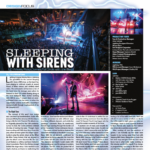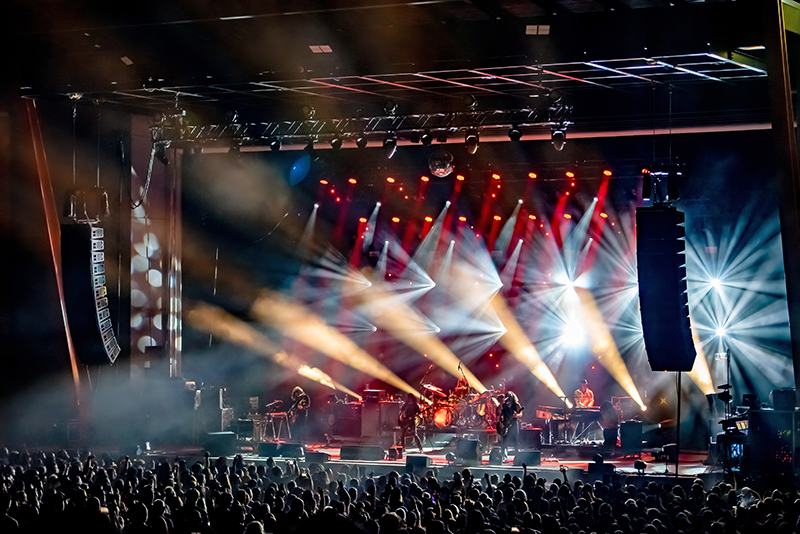
The band, My Morning Jacket, led by vocalist/guitarist Jim James, has been around since it formed in 1998 in Louisville, KY. While their sound is rooted in rock and country, it’s also experimental and psychedelic. Lighting and Production Designer Marc Janowitz started working with My Morning Jacket (MMJ) in the mid-2000s. He took some time to speak with PLSN about his design work for the band over the 17 years he’s been supporting their music with his lighting and visuals.
How did you come to be the Lighting/ Production Designer for My Morning Jacket?
My first show with MMJ was in March of 2006. I had been working closely with Marc Brickman for many years at the Blue Man Group. He had lit MMJ’s concert film Okonokos in 2005. When MMJ began looking for a touring LD for their 2006 tour, he passed my info along to the band’s management.
Do you operate the show as well?
Yes, I am the tour lighting director and a ‘working LD.’ From the moment the house lights go out to the band’s final bow is my favorite part of the job. There’s just nothing quite like it. Rocking the lights with these guys is a real high.
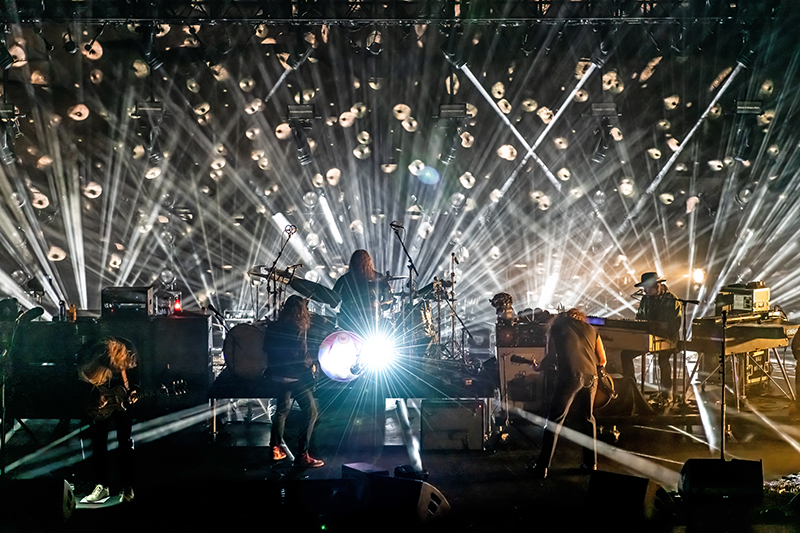
Does James give you any directions, suggestions, collaboration on what he wants?
Jim and the rest of the band have given me a wide degree of freedom in how to create the visual space. Often times it’s been ‘direction by negation.’ As in ‘here are the things we don’t want or don’t like. We can’t spend that, can you do it a different way?’ And then from there I was free to move forward.
There was a point early last year [2022] when the band had a heart to heart with me wherein, we opted to streamline some of the structures and the rig to ‘get back to basics’ if you will. I wanted to have a tungsten or tungsten-emulated audience blinder and I ended up implementing a bunch of the CHAUVET STRIKE 1s and STRIKE P38s. There are a lot of great LED emulators out there right now however the STRIKE series red shift and dimming curve—especially down low—makes it the most like a tungsten blinder that I’ve found yet for my purposes. The combination of the larger sized STRIKE 1’s and its baby brother, the P38, allows me to fill a lot of nooks and crannies. With these two fixtures in the rig, I can create the classic big audience blinder effect or the barest little candle like twinkles and every modulation between the two spectrums. Top that off with its strobing capability and it has become my go to blinder.
In the spirit of back to basics, I opted away from any sort of color changing moving pixelated strobe and I just went back to the Atomic 3000, which I love. After a year of trying to maintain 20-year-old Xenons on the road, we upgraded to the Atomic LED. It is many times brighter than the original and has been quite reliable. That powerful white pierces through everything else!
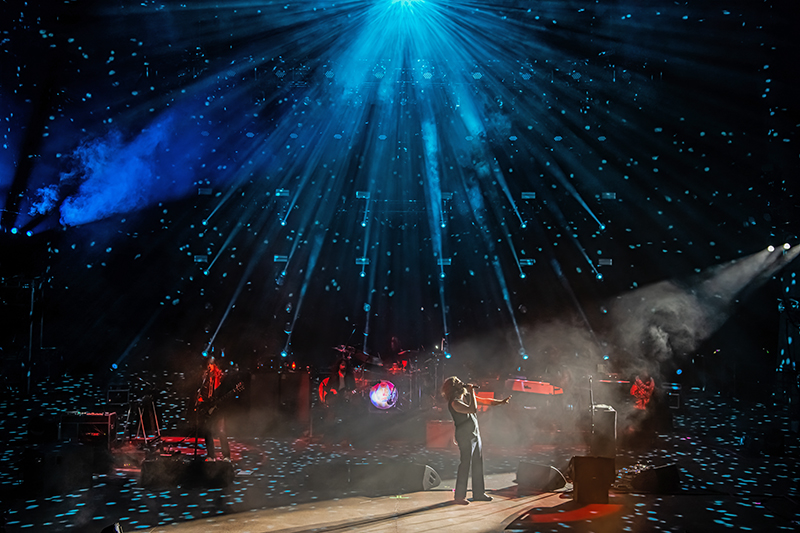
Talk about your design process.
When selecting fixture types I generally start most designs with a profile. The spot is going to be the workhorse fixture. This design that we’re looking at now is very much an evolution of sorts from many years of working with this band. There are certain elements I bring with me from year to year and certain ones I change creatively and aesthetically. Certain ones I change for pragmatic purposes to serve a more utilitarian way. For instance, my workhorse profile for many years on this band and others was the Robe BMFL. Before that it was the [Vari-Lite] VL3000 (yay clown-puke gobo!). This year some of the production needs dictated a smaller footprint, both size and weight wise.
In my forever search to find fun things to bounce light off of—in addition to the 30” mirror ball that trims out about 35’ over the center stage—I added some 18” half mirror balls that sit on the stage deck upstage of the band, so you actually never really perceive that they are mirror balls but when you point all the different [Robe] MegaPointes at them you get this great starburst effect. The motors are variable speed and reversible so you can get a good three or four songs out of them before it feels like the gag’s maybe getting a little bit played out.
Tell us about your fixture selections. What is your workhorse unit?
All tools in the toolbox. Before getting specific on what exact light(s) to use, I generally breakdown the design into categories and types, i.e., spots, washes, beam light/hybrids, strobes, practicals, display type (fixtures meant to be looked at, as opposed to directed at something else). Though I have my favorites, and go-to’s on actual fixtures and manufacturers, it’s the category/type I specify first, based on the visual needs of the show. Often times the final fixture selection will be based on other factors like budget, logistics, availability, size, weight, etc.
So, ultimately after years of using the BMFL, the spot changed to the Aryton Mistral, which is half the size and half the weight. The drawback is that it delivers noticeably less intensity. This forced me to look at how I could use the rest of the rig in a more versatile manner by filling in what I call the ‘gaps’ created by this discrepancy. I leaned heavily on my Robe MegaPointes to handle some of the more intense beam work. The looks were quite harmonious between the two effects and parameters of the two different system offerings.
I started using the GLP X4 back about 2012 and had probably the first 50 or 60 of them shipped to the U.S. I used them on that year’s My Morning Jacket tour because I needed a small lightweight fixture that I could literally dangle from these festoons we had built out of truss ladders. I’m still using the X4 with this band in this current plot, despite GLP’s new offering: the X5. Honestly, when it comes down to it, this 12-year-old unit is still great. It fits in the rig where I need it, does everything I need it to do, and the price point is terrific. Plus, the guys at Pulse are more than happy to get their older inventory off the shelf!
We have really homed in this year on the Follow-Me [Remote Followspot] system. In some ways it has been a real game-changer for my strategic approach to how I light the music as not just creating pictures but how I really try to feature different band members doing different things in a way that feels fresh and different for every song. Basically, I can take control of any fixture in the rig, or any combination of them. When Jim or Carl [Broemel]—or both—are going to come down stage and shred a guitar solo I can have a bunch of different lights from different parts of the rig just swoop in on them, follow them wherever they are. I could either choose to maintain the fixtures in whatever color or gobo they were when they were doing the stage picture, or I can have another variety where they bump to open white or to an open gobo. The effect sort of melts out of that picture from whatever direction they happen to be coming from, especially with the exactness of all these instruments following him wherever he goes. It’s been really fun, and I think, an interesting way to feature guys who are moving around a lot on the stage. The really great and unique thing about Follow-Me is that it’s not manufacturer specific and you can have as many multiple lights as you want on it at any time, and it’s all assigned from the console.
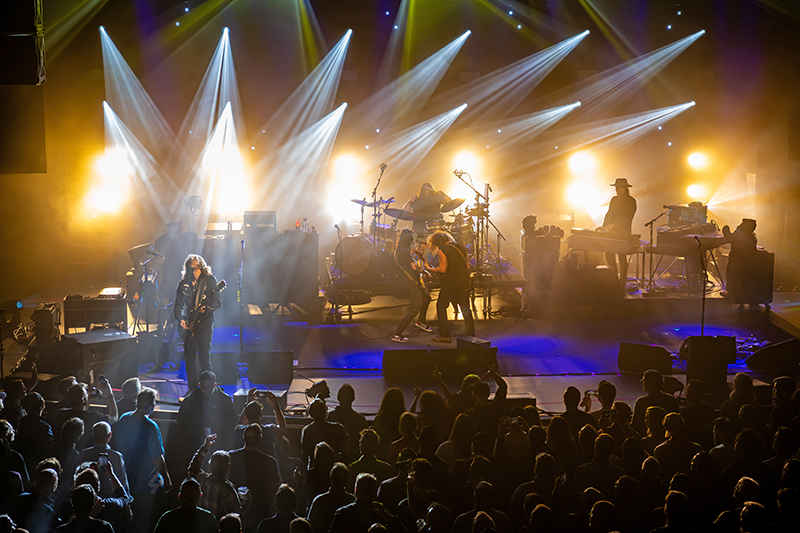
With the wealth of fixtures with multi parameters / FX available in them, how do you achieve your unique visual style?
Every project deserves its own unique approach. I consciously avoid designing anything into the show for its own sake if it doesn’t have a purpose. For instance, I wouldn’t design in a video surface if there wasn’t something already conceived to go on it. My base point of design is creating a cocoon of light for the band to be enveloped in. It’s what I call my old standby, my old faithful.
It’s just 12 ETC Source Four PARs with some opal frost. I place them on the stage deck and on floor stands stage right and left and just create a little bit of a circle of low side light for them. The band works in this nice emanating glow that is reminiscent of a campfire and very intimate. Sometimes I’ll make it a bit dramatic by only glowing one side or the other. I don’t know if you would call it a signature look but it is a tool, I bring in my toolbox for a number of projects.
What drives you and your creative visions?
One of the things that I feel as a designer has really liberated my aesthetic is the embrace of asymmetry. To me it just feels like what light does in real life. In nature no matter how perfect the sunrise or sunset is it’s never perfectly centered with all of its beams extending mathematically out from the middle. Or at least it never seems to in my perception. Sometimes I have the luxury, the space, time, and budget to design an actual fixture layout and stage that’s not symmetric. Balanced but not symmetric and in some ways liberating, because if your rig’s not symmetric, it forces you to create balance without ever actually being able to make that kind of mirrored image thing that we see so much lighting. Not the case with our ‘streamlined’ straight truss arrangement on this tour.
Within this framework I am finding ways to use groups of fixture selections and directions that are coming from places that are not standard. Stretching from one side to the other and then balancing that out by coming from way upstage right with six lights that splay out across the stage and then balancing from the other side with maybe six floor lights from across the other side and then maybe sprinkling in some of the more display type fixtures.
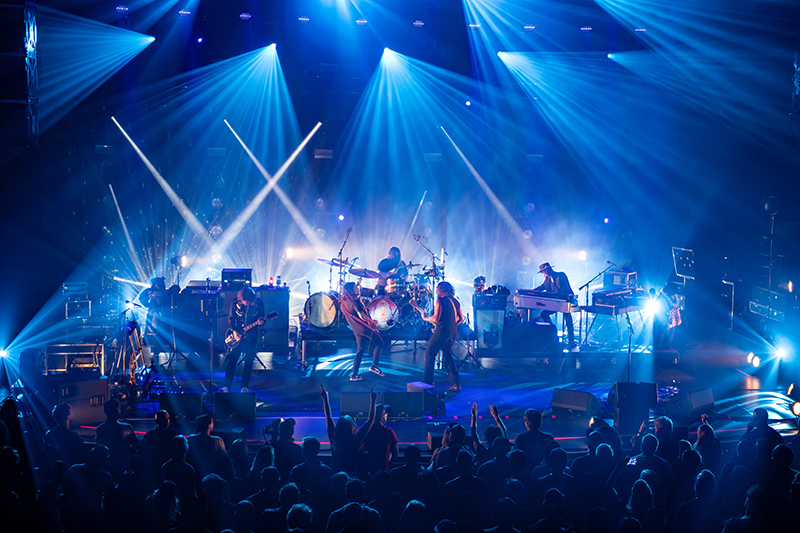
Is this show timecoded?
No timecode. It’s a very ‘LIVE’ act and my operation is very hands on. I run the show on a [High End Systems] Wholehog 4-18 and have four additional USB playback wings. That gives me access to 50 playback faders at any time.
Talk about the support of your crew and vendor.
Pulse Lighting in Nashville has been our vendor since 2019. I consider them a boutique shop in the best sense of the word. Paul Hoffman takes a very personal interest in the success of each and every project. They are more like a partner than a vendor. My crew is outstanding. Kenny Gribbon as Crew Chief with Patrick Fitzgibbons, Jessica Sanders, and Nick “Dragon” Rotondi rounding out the team. We’ve also been very fortunate to have Patrick Dickinson as our tour Production and Stage Manager. He took over in 2022 when I gave back the hat. He’s a veteran of the industry and a giant of a player.
Arguably, our biggest challenge on this tour is the truck pack. Pat Dickinson makes all this fit in two trucks with backline, audio, line array, merch, lighting, and production office. He does so in a way that is makes sense and doesn’t kill anyone.
Were venues on the current tour consistent? What challenges did they present?
Far from it! Venues have been everything from 1,000 seat clubs to 15,000 seat amphitheaters. Festivals, parking lots, a cemetery (possibly 2) … We had to get our hang weight down to accommodate the myriad of venues this year, some of which were temporary stages where every pound counts.
Did you design the set as well?
Any and all visual elements of the show. Over my 17+ years with MMJ that’s included set, lights, video, special effects, gags, etc. For seven years I also Production Managed the tour. It was a very busy time… After the 2021 tour I realized it was time to step away and have someone else wear the PM hat.
I also stepped away from including truss structures in different shapes as part of the scenic design and returned to a standard straight truss configuration with a floor package, but I noticed a lot of negative space. I wanted to fill in—what I call the ‘sky’—a bit and so I brought back the [GLP] KNV Dot which I had used on the 2021 tour. I have about 80 of those that are mounted to two-foot bars on angles. These bars kind of just zigzag across each truss. I use them to create undulating color or create larger kind of sweeps of color across everything but in a way where it’s not really illuminating anything, and it’s not really meant to be a blinder—more of a color twinkle. But then inside of that color ring it has a white LED in the center. That white source really cuts through and makes that twinkle kind of just become a supernova for a moment and go away so that’s been kind of great for creating a ‘backdrop’ of stars.
Is there anything else that you would like to mention about working with James and My Morning Jacket?
After 17 years, and over 400 shows, any words to describe the bond would simply fall short. One word that comes to mind often is ‘symbiotic.’
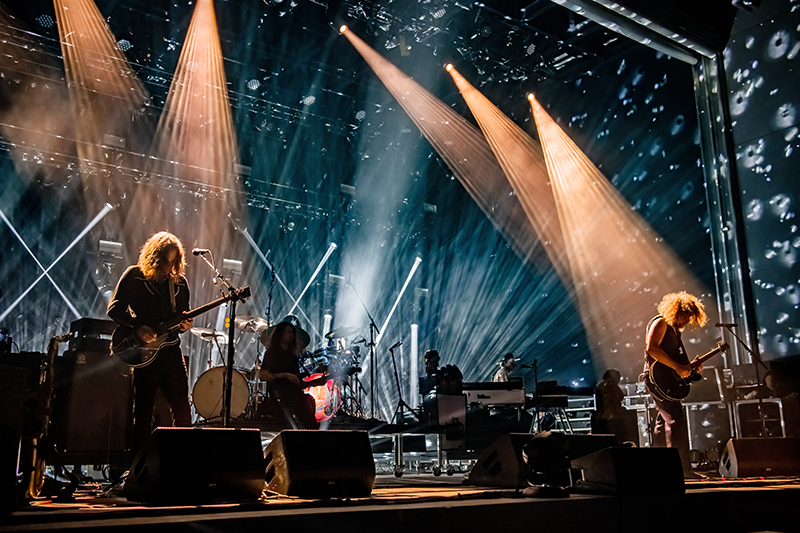
VENDOR VIEW
Paul Hoffman, Co-Owner of Pulse Lighting
After touring with The Dead in 2004, Lighting Designer Paul Hoffman co-founded Pulse Lighting in 2005 with his brother Preston, who is also a lighting designer. Based in Nashville, TN, Pulse Lighting has been the lighting vendor supporting Marc Janowitz and My Morning Jacket since 2019.
In speaking with Marc Janowitz, he considers Pulse Lighting a ‘boutique shop in the best sense of the word.’ How do you feel about that statement?
I would agree with him, but I believe he’s talking about more than just size. Pulse has been crafted over the years to serve a limited list of clients in an exceptionally involved and focused manner. This approach allows us to establish deep, meaningful, and long-standing relationships and gain a profound understanding of each client’s unique needs and working style. We are much more interested in those types of relationships than big one-off events for people we may never work with again.
You mentioned that your interest in the design side of a project runs so deep that you delve in as collaborators to make client’s projects happen as a tourable, travelable package, and present well on stage.
The enjoyable thing about working with Marc, as his lighting vendor, is that he has lots of interesting ideas, very outside of the box. There is always a custom aspect to his design from a hardware point of view that requires the placement of a light in a place where people just don’t normally put lights. He definitely decides what it’s going to look like, and where it goes.
In addition to running Pulse, both you and your brother Preston are lighting designers. Speak about that and how it informs your Pulse Lighting work.
Yes, we are both active LDs on the road and we both still work on projects in the field in addition to running the company. We take a lot of interest in the design part of what’s going on, not just the hardware required. Though, make no mistake, it is the gear that we make our money from, so we take very good care of our investments.
Marc likes to walk around our warehouse—usually at 2a.m.—or as the truck is in its final stages of loading, doing what he calls ‘shopping’. That’s how he came across the half mirror balls we’ve had forever. Purchasing inventory is more an art than a science. When Marc brought the GLP KNV Dot fixture to our attention, I dove right in. Marc described to me how he was going to create ‘constellations in the sky’ with them and I had to see it… and it made good business sense. It’s not as well-known as the other offerings in the GLP line but it is a really versatile unit.
Likewise, with the Follow-Me remote followspot system. We had been researching remote followspot systems, definitely leaning towards this one, and when Marc put them on his tour last year it was a done deal.
As designers, we want to see the cool designs happen. A lot of times there will be things where XYZ isn’t necessarily in the budget per se but it’s so compelling that I just really want to see it happen. We work together with Marc pretty well in that regard so I’m able to give a little bit on something and he’s able to give a little bit on another project at other times. That’s just how it works between us, so yes ‘boutique’ is a good fit.
